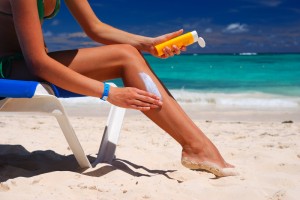
One of the many great attractions of Arizona is the abundant amount of sunny days that we have year round. Compared to most other places that have frequent cloudy and rainy days that can be mood depressing, annoying and activity interfering, most days of the year here we have spirit lifting sunshine and beautiful blue skies.
We can truly enjoy the outdoors with few limitations. When it does rain, we actually look forward to it as either needed or as a nice, but brief, change.
While all this is great, we should consider that for all the positives associated with sunny days there can be negatives – like sunburns and skin damage from chronic sun exposure. If we take some precautions we can minimize the development and extent of these issues.
Like protecting our skin with sunscreen and sun protection clothing.
The following covers some useful information regarding sunscreens and protecting your skin from damaging effects of the sun’s ultraviolet (UV) rays.
Should I select a sunscreen based on its SPF number?
There are really an incredible number of sunscreens to select from which can make things very confusing. They have different SPF numbers, varying sun protecting ingredients, different percentages of these ingredients, chemicals versus barrier agents, water resistance vs water proof, etc.
To make matters worse, there is no one “best” sunscreen and there are many different opinions as to what are some excellent sunscreens.
So, how do you choose?
You can begin by looking for a sunscreen that has a high SPF number. Though many dermatologists recommend an SPF of 30, which blocks about 97% of the sun’s UV rays, I don’t subscribe to that opinion – particularly here in Arizona. Look for one with a SPF of at least around 45 or higher. It will offer you more protection which is exactly what you want.
The other two important characteristics of the sunscreen should be “broad spectrum” coverage and water resistance. The broad spectrum component will provide both UVA and UVB protection, and not just UVB protection, so that your skin is also protected from photo aging and skin cancer risks.
Ultimately, you may have to try several different sunscreens that have these three characteristics until you find one that works best for you overall.
Should I just apply sunscreen when I am doing outdoor activities?
Yes, you can. However, you will not be adequately protecting your skin.
Going to the store, work, school or any other place during the day will expose your skin to the harmful effects of the sun’s UV rays. You don’t have to be just sitting by the pool for this to happen. This exposure all adds up over time.
Therefore, at minimum, it would be very prudent to apply sunscreen every day that you will be outdoors in some capacity.
If I apply sunscreen in the morning, is that good enough?
It may be. However, if you are planning on spending any significant amount of time outdoors aside from driving and going from place to place, this will not provide you with adequate protection.
The general recommendation is to apply the sunscreen about every two hours when you are engaging in outdoor activities. If you are swimming, it should even be more frequently.
Are there different categories of sunscreens?
There are two main categories of sunscreens – chemical and physical. The chemical agents absorb the sun’s UV rays, thereby protecting the skin. Some of the more commonly used agents include oxybenzone, avobenzone, homosalate, octisalate, octocrylene and octinoxate.
The physical agents provide a barrier to the sun’s rays. These include zinc oxide and titanium dioxide. This type of sunscreen may contain either agent or both in the formulation. It is also often associated with a “whitish” appearance.
Can sunscreens reduce the sun related aging of my skin?
The long term and regular usage of sunscreen will absolutely reduce sun induced skin aging. By blocking the sun’s UVA and UVB rays from reaching and damaging the skin, wrinkling, pigmentation changes, loss of elasticity and other signs of sun damage can be reduced. Therefore, you can look more youthful for a longer period of time.
In addition, it is also prudent to minimize sun exposure in general and in the mid-day in specific.
How soon before going outside should I apply sunscreen?
It is generally recommended that you apply your sunscreen at least 15 to 20 minutes before going outside. This does not necessarily hold true for the physical sunscreens containing zinc oxide or titanium dioxide.
Is sun protection clothing useful?
You might not have realized it but the average T- shirt does not provide your skin with much protection against the sun. In fact, it typically has a SPF of around 4 to 7 which is reduced to 3 when wet.
That is not very much at all!
If you are outdoors for a while, a lot of sun is getting through your shirt and causing skin damage.
Special sun protection clothing can be extremely effective in protecting your skin from sunburns and skin aging. They can be used separately or in conjunction with sunscreen to provide you with maximal sun protection while outdoors. Many have a SPF of 50 or greater.
Examples of useful sun protection clothing are long and short sleeve T-shirts, blouses, hats with ear and neck flaps sport specific shirts, gloves, neck protectors and swim shirts. There are a few reputable companies that do make excellent and effective products. Two which I can definitely recommend considering are Coolibar® (www.coolibar.com) and Solumbra® by Sun Precautions® (www.sunprecautions.com). In my opinion, Coolibar’s products subjectively feel and look more normal and natural.
So have fun in the sun but remember to protect your skin as much as possible.
Steven H. Turkeltaub, M.D. P.C.
Scottsdale and Phoenix, Arizona
